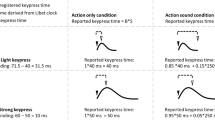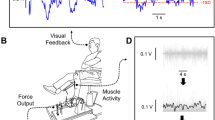Abstract
Could task performance be constrained by our ability to fully engage necessary neural processing through effort of will? The StartReact phenomenon suggests that this might be the case, as voluntary reaction times are substantially reduced by loud sounds. Here, we show that loud auditory stimulation can also be associated with an improvement in the force and speed of force development when 18 healthy subjects are repeatedly asked to make a maximal grip as fast and as strongly as possible. Peak grip force was increased by 7.2 ± 1.4% (SEM) (P < 0.0001), and the rate of force development was increased by 17.6 ± 2.0% (P ≪ 0.00001), when imperative visual cues were accompanied by a loud auditory stimulus rather than delivered alone. This implies that loud auditory stimuli may allow motor pathways to be optimised beyond what can be achieved by effort of will alone.



Similar content being viewed by others
References
Angel A (1973) Input-output relations in simple reaction time experiments. Quart J Exp Psych 25:193–200
Baumgartner T, Willi M, Jäncke L (2007) Modulation of corticospinal activity by strong emotions evoked by pictures and classical music: a transcranial magnetic stimulation study. Neuroreport 18:261–265
Bohannon RW, Peolsson A, Massy-Westropp N, Desrosiers J, Bear-Lehman J (2006) Reference values for adult grip strength measured with a Jamar dynamometer: a descriptive meta-analysis. Physiotherapy 92:11–15
Bonanni L, Thomas A, Onofrj M (2010) Paradoxical kinesia in patients surviving earthquake. Mov Disorder 25:1302–1304
Brown P, Rothwell JC, Thompson PD, Britton TC, Day BL, Marsden CD (1991) New observations on the normal auditory startle reflex in man. Brain 114:1891–1902
Carlsen AN, Chua R, Inglis JT, Sanderson DJ, Franks IM (2004) Prepared movements are elicited early by startle. J Mot Behav 36:253–264
Carlsen AN, Chua R, Inglis T, Sanderson DJ, Franks IM (2007) Differential effects of startle on reaction time for finger and arm movements. J Neurophysiol 101:306–314
Coombes SA, Cauraugh JH, Janelle CM (2007) Emotional state and initiating cue alter central and peripheral motor processes. Emotion 7:275–284
Coombes SA, Tandonnet C, Fujiyama H, Janelle CM, Cauraugh JH, Summers JJ (2009) Emotion and motor preparation: a transcranial magnetic stimulation study of corticospinal motor tract excitability. Cogn Affect Behav Neurosci 9:380–388
Daroff RB (2008) Paradoxical Kinesia. Mov Disord 23:1193
Dufft CC, Ulrich R (1999) Intersensory facilitation: also concomitant visual stimuli can decrease reaction time. Z Exp Psychol 46:16–27
Fess EE (1992) Grip strength. In: Casanova JS (ed) Clinical assessment recommendations. American Society of Hand therapists, Chicago, pp 41–45
Giray M, Ulrich R (1993) Motor coactivation revealed by response force in divided and focused attention. J Exp Psychol Hum Percept Perf 19:1278–1291
Glickstein M, Stein J (1991) Paradoxical movement in Parkinson’s disease. Tr Neurosci 14:480–482
Househam E, McAuley J, Charles T, Lightfoot T, Swash M (2004) Analysis of force profile during a maximum voluntary isometric contraction task. Muscle Nerve 29:401–408
Jaśkowski P, Rybarczyk K, Jaroszyk F, Lemański D (1995) The effect of stimulus intensity on force output in simple reaction time task in humans. Acta Neurobiol Exp 55:57–64
Jepma M, Wagenmakers EJ, Band GP, Nieuwenhuis S (2009) The effects of accessory stimuli on information processing: evidence from electrophysiology and a diffusion model analysis. J Cogn Neurosci 21:847–864
Langerström C, Nordgren B (1998) On the reliability and usefulness of methods for grip strength measurement. Scand J Rehabil Med 30:113–119
Liegeois-Chauvel C, Morin C, Musolino A, Bancaud J, Chauvel P (1989) Evidence for a contribution of the auditory cortex to audiospinal facilitation in man. Brain 112:375–391
Mazzoni P, Hristova A, Krakauer JW (2007) Why don’t we move faster? Parkinson’s disease, movement vigor and implicit motivation. J Neurosci 27:7105–7116
Miller J, Franz V, Ulrich R (1999) Effects of auditory stimulus intensity on response force in simple, go/no-go, and choice RT tasks. Percept Psychophys 61:107–119
Mordkoff JT, Miller JO, Roch AC (1996) Absence of coactivation in the motor component: evidence from psychophysiological measures of target detection. J Exp Psychol Hum Percept Perf 22:25–41
Posner MI, Nissen MJ, Klein R (1976) Visual dominance: an information-processing account of its origins and significance. Psychol Rev 83:157–171
Queralt A, Weerdesteyn V, van Duijnhoven HJ, Castellote JM, Valls-Solé J, Duysens J (2008) The effects of an auditory startle on obstacle avoidance during walking. J Physiol 586:4453–4463
Reynolds RF, Day BL (2007) Fast visuomotor processing made faster by sound. J Physiol 583:1107–1115
Sanders AF (1983) Towards a model of stress and human performance. Acta Psychol 53:61–97
Schmidt L, Cléry-Melin ML, Lafargue G, Valabrègue R, Fossati P, Dubois B, Pessiglione M (2009) Get aroused and be stronger: emotional facilitation of physical effort in the human brain. J Neurosci 29:9450–9457
Stahl J, Rammsayer TH (2005) Accessory stimulation in the time course of visuomotor information processing: stimulus intensity effects on reaction time and response force. Acta Psychol 120:1–18
Valls-Solé J, Rothwell JC, Goulart F, Cossu G, Muñoz JE (1999) Patterned ballistic movements triggered by a startle in healthy humans. J Physiol 516:931–938
Woodworth RS (1938) Reaction time. In: Experimental psychology, Holt, New York, pp 317–326
Acknowledgments
PB is supported by the Medical Research Council and the Oxford NIHR Biomedical Centre.
Author information
Authors and Affiliations
Corresponding author
Rights and permissions
About this article
Cite this article
Anzak, A., Tan, H., Pogosyan, A. et al. Doing better than your best: loud auditory stimulation yields improvements in maximal voluntary force. Exp Brain Res 208, 237–243 (2011). https://doi.org/10.1007/s00221-010-2474-1
Received:
Accepted:
Published:
Issue Date:
DOI: https://doi.org/10.1007/s00221-010-2474-1




